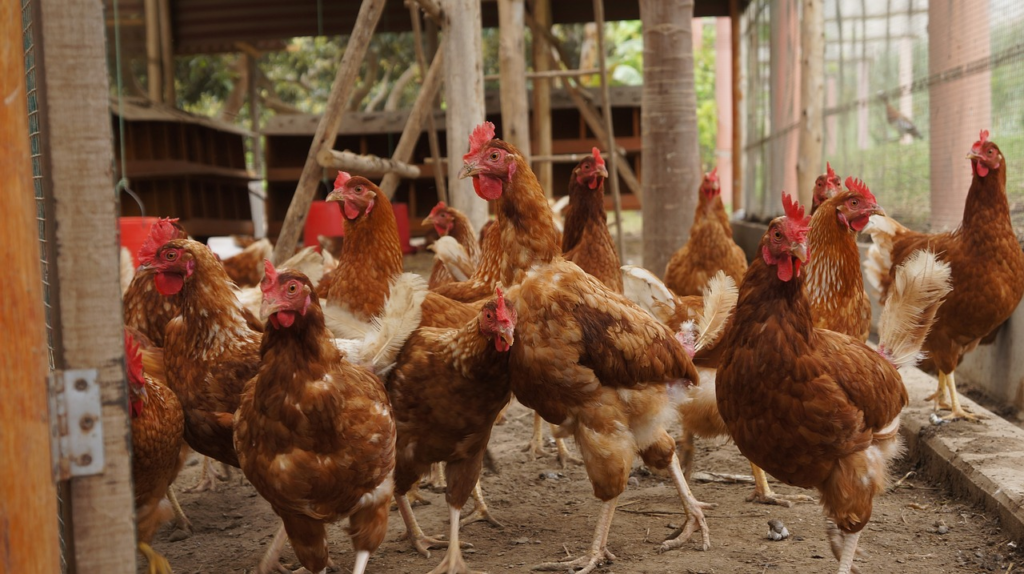An outbreak of bird flu in October 2022 spread rapidly through a mink farm in the Galicia region of Spain. This received massive media coverage, as it renewed concerns that the virus could adapt to humans. But this outbreak was part of the much larger, unprecedented, currently ongoing H5N1 panzootic that has caused massive losses in global wild bird and mammalian populations. Given the continued global prevalence of these H5N1 viruses and their unique ability to cross the species barrier from birds into mammals, insights from the mink farm outbreak and similar scientific studies warrant a fresh look.

In October of 2022, an outbreak of H5N1 (bird flu) occurred on a mink farm in Spain. Throughout Europe there are many such “fur farms” where small mammals are bred and raised for the commercial sale of fur. The farm at the center of this outbreak is in the Galicia region of Spain.
A place of beauty, Galicia is located on Spain’s Northwest corner, with the Atlantic Ocean to the North and the West and bordered by Portugal to the South. On its Western edge lies Cape Finisterre, a rocky cliff face jutting out of the sea, which the Romans called the “end of the earth.”
In the early days of October, farm workers began noticing an unusual uptick in mink deaths. The mortality rate of the minks increased each week, and by mid-October entire pens of animals were dying within 1–2 days. As the minks continued to die, testing revealed the animals were infected with H5N1. Culling operations were ordered by the animal health authorities, and by mid-November all remaining minks were culled. More than 50,000 minks were housed at this farm, grouped together in wire netting cages that were placed throughout partially open-air 30 barns.
In January 2023, a study was published in Eurosurveillance which detailed the genetic analysis of the virus and the epidemiological investigation of the outbreak. The H5N1 virus was of clade 2.3.4.4b and belong to the genotype that has been found in wild birds in Western Europe. However, the mink viruses differed from those found in wild birds by multiple mutations. One “uncommon” mutation known to increase viral replication in mammals, was found in all the mink viruses sampled. As noted in the study, this mutation was also present in the 2009 swine flu pandemic virus.
During the investigation, it was found that in the weeks preceding the outbreak, there were reports of wild birds dying of H5N1 along the region’s coastline. The authors of the study hypothesized that the virus may have spilled over into the minks from wild birds. The barns which housed the minks were partially open: the buildings provided overhead protection to the animals but not full protection on the sides. Taken together with the reports of wild birds dying of H5N1 in the same area at the time, it would have been possible, if not probable, that the farm was infected by contact with an infected bird.
As to human exposure, 12 people worked at the fur farm, and 11 of them had contact with the animals. No person tested positive for the virus, so there was no further spillover into humans. At the time of the outbreak, workers had been following protocols established during the Covid-19 pandemic, which required them to wear face masks. After the first indication of an outbreak the workers stepped up biosecurity and used face shields, disposable coveralls, changed their masks more often and washed their hands more often.
But perhaps most alarming was the finding that “onward transmission of the virus to other minks may have taken place in the affected farm.”
Are we actually talking about H5N1 efficiently and rapidly spreading through thousands of mammals? Sustained mammal-to-mammal transmission? That is unheard of for this virus. At least it was before.
To be sure, prior laboratory studies have shown avian flu can be transmitted between mammals, mostly ferrets, but transmission on such a scale as this outbreak was (and still is) unsettling. It was thoughts of these ferret studies that entered my mind when I first read the mink farm study. The ferret is the animal model most often used to study influenza, as ferrets are said to experience influenza in a way similar to humans. (Lucky them). What troubled me was how closely related ferrets and minks appear to be. Just look at this ferret and then google “mink farm”, and you will see.

To a non-animal specialist like myself, these almost look like the same animal; although one is coveted for their fur, and the other for their role in scientific study. Looking at these pictures, after reading about the massive H5N1 outbreak on the Spanish mink farm, I had a feeling of uneasiness. I considered the implications:
Again, the ferret is the gold standard for influenza studies. Scientists don’t test deadly flu viruses on humans; they test them on mammals, like ferrets. This is because the clinical course and symptoms of influenza infection in ferrets resembles influenza infection in humans. Now, ferrets and minks seem awfully similar, right? So if H5N1 can gain the ability to transmit through a mink population from one animal to another, why wouldn’t it be able to do so with ferrets? And if it can transmit through ferrets, why couldn’t it transmit through other mammals, or even humans? Obviously this can’t be said as a certainty, but in theory. Why else would scientists use ferrets in studying influenza transmission if not to gain insight into how influenza viruses might behave if they infect humans?
Indeed, ferret-to-ferret transmission of H5N1 was the unsettling finding of two studies published back in 2012. The findings and results, while fascinating, were also terrifying, and the studies caused some controversy before they were published. They are however, worth a glimpse now given the recent exploits of H5N1 in mammals:
- In the first study, published in May 2012, a laboratory-generated H5N1 reassortment virus was found to be “capable of respiratory droplet transmission in ferrets.” In the study, the scientists created a virus by taking the HA gene (i.e., the “H” in H5N1), from an existing H5N1 virus and combining that with seven genes from a 2009 pandemic H1N1 virus. This H5N1 virus “replicated efficiently in ferrets” and “preferentially recognized human-type receptors.” Well that was all very fascinating and horrifying. The good news was, while the virus was found to have been spread via respiratory droplets, it was “not highly pathogenic and did not cause mortality.” So the laboratory-created H5N1 was not highly virulent and did not kill the ferrets, but it did transmit between them.
- In the second study, published in June 2012, a genetically modified H5N1 virus was found to be “airborne-transmissible” between ferrets. Scientists took an existing H5N1 virus and inserted some mutations into the HA gene (the “H” in H5N1), mutations that were known to enhance binding to human receptors. Next, they inserted a mutation (PB2 E627K) known to signal mammalian adaptation and expanded host range into one of internal genes (the PB2 gene) of the virus. Ferrets were infected with these mutated mutant H5N1 viruses, but there was no transmission. After that, it gets really exciting. The scientists wanted to “force the virus to adapt to replication in the mammalian respiratory tract[.]” This was done by a technique called passaging: where a virus is given to a ferret that sheds the virus, and then that virus from the sick ferret is given to another ferret, and so on. This mimics the way a virus spreads in nature, the idea being that the more it is passed from one animal to another, the more the virus will mutate and adapt. Here, by the 4th passage, there was evidence of adaptation. By the 10th round, the H5N1 viruses were airborne-transmissible between ferrets. These infected ferrets exhibited fairly mild symptoms and none of them died. So again, while the virus did transmit between the airborne contact ferrets, it was not highly pathogenic.
- A more recent study, currently a pre-print published in April 2023, revisits the ferret transmission model with some interesting results. An H5N1 clade 2.3.4.4b virus from a hawk that was naturally infected in Canada was “efficiently transmitted by direct contact between ferrets, resulting in lethal outcomes.” That is a change that gives me pause. An H5N1 of the clade currently circulating around the globe was transmitted between mammals in a lab and was highly virulent. Even the authors of the study were surprised. In analyzing the genetic components of the hawk virus, it was found to contain a mutation (PB2 E627k) associated with mammalian adaptation. This mutation is well known in the scientific community, and it was this mutation that was used in the June 2012 ferret study to create a mutant transmissible H5N1 virus.
Given this laboratory evidence that H5N1 could gain the ability to transmit amongst ferrets, perhaps it was not entirely shocking that it eventually transmitted between minks. But it felt shocking. What can happen under experimental conditions is not the same as what could happen in nature, but this did happen.
Beyond the examples of H5N1 transmitting between mammals in the lab, the Spanish mink farm outbreak seemed reminiscent of something else: live poultry markets of Hong Kong and other places in Southeast Asia. Back in 1997, it was in these markets in Hong Kong that H5N1 first spilled over into humans. That H5N1 virus, vintage H5N1, jumped from poultry directly into people, infecting 18 and killing 6 of them. Hong Kong halted the outbreak by culling all the birds. It was after this that live poultry markets were criticized and subjected to more intensive biosecurity measures, or closed down entirely.

Looking back it isn’t surprising that H5N1 arose in a live poultry market setting. The conditions present clearly favor zoonotic disease outbreaks: groups of animals housed close together sometimes in unsanitary conditions, constant direct human to animal contact, the slaughter of live animals and contact with animal fluids and droppings, etc. Many of these conditions are mirrored in commercial poultry farms and fur farms beyond Southeast Asia, like the mink farm in Spain.
I will note that the H5N1 currently circulating is a far cry from vintage H5N1 of the late 1990s and early 2000s. There is wide speculation about the current mortality rate in humans. That does not mean we should be complacent. There are many things that science does not understand about influenza, and this gap of knowledge seems even more pronounced with this clade of H5N1.
This H5N1 virus has shown a unique fitness for infecting and killing various species of wild birds and mammals. It has also achieved efficient mammal-to-mammal spread in localized outbreaks. We don’t know why. That is the subject on ongoing scientific inquiry and study. But certainly a takeaway from the 2012 ferret studies, beyond the fact that mutant H5N1 viruses could infect and spread between mammals, was a clear example of how genetic mutation influences viral adaptation towards mammal-to-mammal transmission.
So does that mean the answer lies in the genetic components of these H5N1 viruses? This idea is one focal point of ongoing study. For example, one such genetic component was the subject of a research letter that was published in response to the Spanish mink farm study. In that letter, the author noted that the H5N1 mink viruses featured a “disrupted second sialic acid binding site” in the NA gene (i.e., the “N” in H5N1). This is thought to “drive selection for changes in the receptor binding properties” of avian viruses. This component is a recognized “marker of influenza virus adaptation to humans” and has been present in prior pandemic flu viruses.
Now, you don’t have to be a scientist, and you don’t have to even understand what any of that really means, in order to grasp the key point that such a characteristic has implications for human health. According to the authors, his genetic component, the “disrupted second sialic acid binding site”, impacts the viral properties of receptor binding and host rage. Those two things are very important for novel viruses.
Indeed, the host range of H5N1 is changing right now. It is happening all over the world. It has been happening for several years on a massive scale, as more mammals have been infected with H5N1 than ever before. That the virus has infected mammals so readily is itself alarming, but even more concerning is the fact that this virus has the ability to infect and kill different species of mammals. And this is after this H5N1 has already expanded its host range and shown the ability to infect a kill different species of wild birds. So we are watching evolution unfold in real time.
The studies like those done with ferrets, discussed above, and those done in response to the mink farm outbreak, are invaluable to the understanding of how avian flu viruses operate. However, this clade of H5N1 has changed the state of scientific understanding about avian flu. The persistence of the virus in wild birds through multiple seasons, the increasing number of mammalian spillovers, and now the apparent transmission between a large population of closely-housed mammals, signal changes in this virus’ evolution and ecology.
What does that mean for host range and receptor binding? As H5N1 continues to infect new species of mammals, its host range continues to expand. The more mammals it infects, the more opportunities this virus has to adapt to mammals, with components like receptor binding changing to favor infection in mammals. And the more the virus circulates in the environment, the more opportunities there will be for spillover events from animal-human interactions.
The risk right now to humans is low, and has remained low. But the shift towards more mammals being infected raises a key question: how many routes can this virus take towards adaptation and transmission in humans? It is clear from the ferret studies discussed above, as well as the studies on the mink farm outbreak, that there isn’t just one way for H5N1 to change its host range and receptor binding qualities. Moreover, the scientific community is always on alert for known viral mutations and adaptation markers, but there is so much unknown. The only thing that is known for sure is that influenza viruses are ever-changing and rapidly evolving.
Indeed, the only constant here is change.
Until next time.
For more bird flu updates and research study analysis, be sure to read my other articles and follow me on social media.
Leave a comment below and join the discussion, and always feel free to reach out to me!



This blog is an outstanding resource for anyone interested in learning more about related topics.
Reading your blog is always a joy; your writing captivates me every time.
Pingback: New H5N1 ferret study suggests higher viral shedding with current bird flu virus compared to older strains - Bird Flu Studies